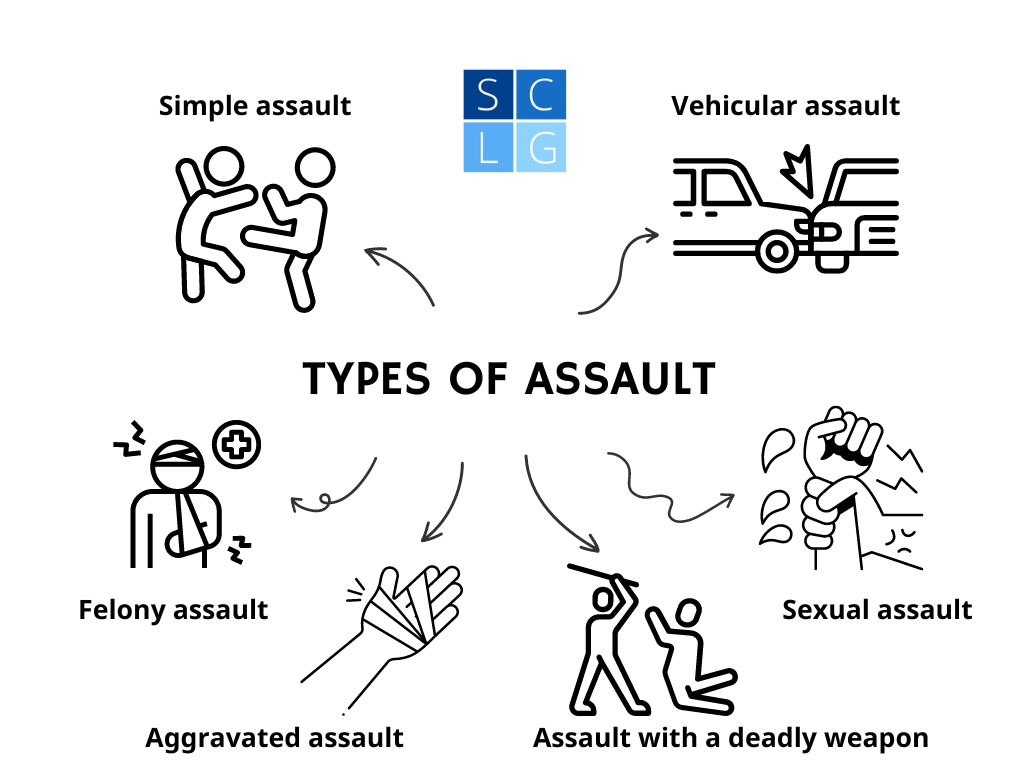
The police recently arrested you for assaulting someone in a bar. How can a prosecutor charge it? Are there really different levels of assault?
Yes. Most jurisdictions recognize six common types of assault charges. These include:
- simple assault,
- aggravated assault,
- assault with a deadly weapon,
- sexual assault,
- vehicular assault, and
- felony assault.
A prosecutor can usually charge an assault offense as either a misdemeanor or felony depending on the facts of your case. Penalties for assault crimes can include:
- jail time or a prison sentence, and/or
- substantial fines.

1. Simple Assault
The criminal laws of most states say that you are guilty of simple assault if you:
- threat or attempt to inflict physical harm or physical injury on someone else, and
- do so while you have the present ability to inflict that harm or injury.1
An example of simple assault is throwing rocks at a neighbor while she is out gardening.
Note that many people often treat assault and battery as the same crime. However, they are separate and distinct offenses.
While you usually commit assault via a threat of violence to someone, you commit battery when you actually use force against that person.2
Simple assault is usually the least severe assault crime, and it is generally charged as misdemeanor assault.
Further, the laws of some jurisdictions set forth different degrees of simple assault. Prosecutors in these states usually have the option to file criminal charges of:
- first-degree assault,
- second-degree assault, or
- third-degree assault.
2. Aggravated Assault
You generally commit aggravated assault if you:
- assault another person, and
- do so under certain “aggravating factors.”
Examples of aggravating factors include assaulting someone and:
- causing bodily harm to the “victim,”
- causing serious bodily injury to the “victim,”
- doing so by a threat of disfigurement or impairment to the “victim,”
- doing so on a public servant or minor.3
3. Assault With a Deadly Weapon
Assault with a deadly weapon is where you:
- assault another person, and
- do so by means of a dangerous object or deadly weapon.4
Note that a “deadly weapon” refers to obvious objects that raise a risk of death, like:
- guns, and
- knives.
But the term can also refer to such things as:
- rocks,
- bottles,
- bats,
- cars, and
- attack dogs.
A judge or jury often determines whether or not something is a deadly weapon after analyzing all of the facts in a case.
Note that some states say that assault with a deadly weapon is a form of aggravated assault. Other states, though, make it a separate crime.
4. Sexual Assault
Some states treat sexual assault as the same crime as rape. In these states, sexual assault/rape is defined as the crime where you:
- have forcible sexual intercourse with another person, and
- do so without that person’s consent.5
Other states, though, make a distinction between the two offenses. In the states that do, sexual assault is generally defined as:
- intentionally making physical contact with the intimate body parts of someone, and
- doing so without that person’s consent.6
An “intimate body part” of someone generally refers to that person’s:
- primary genital area,
- anus,
- groin,
- buttocks, or
- breasts (if a female).
An example of sexual assault is fondling a woman’s breasts without her consent.
Sexual assault charges are often caught up in instances of domestic violence.
5. Vehicular Assault
Some states set forth the distinct crime of vehicular assault. In these assault cases, you commit a crime if you:
- operate or drive a motor vehicle,
- do so in a reckless manner, and
- cause serious bodily harm to another person.7
Example: John is driving drunk with a passenger in his car. While weaving down the road, he loses control of his vehicle and it hits a telephone pole. The passenger suffers a serious head injury as a result of the accident.
Here, John could be charged with both DUI and vehicular assault. This is because he was driving while intoxicated and he drove in a reckless manner and injured his passenger.
6. Felony Assault
Some states use the term “felony assault” to refer to a form of assault that results in felony charges.
For example, felony assault could refer to:
- a serious form of aggravated assault,
- aggravated sexual assault, or
- a serious instance of vehicular assault.
Felony assaults are generally the most severe forms of assault.
Additional reading
For more in-depth information, refer to these scholarly articles:
- Sentence dispositions accorded assault and burglary offenders: An exploratory study in twelve California counties – Journal of Criminal Justice.
- Perceptions of Victims and Defendants in Criminal Assault Cases – Criminal Justice and Behavior.
- Incidence of Non-Fatal Workplace Assault Injuries Determined From Employer’s Reports in California – Journal of Occupational and Environmental Medicine.
- Criminal Law: Assault with Unloaded Gun – Criminal Law Review
- People v. Chance: Analyzing the Assault Statute’s “Present Ability” Requirement – Berkeley Journal of Criminal Law.
Legal References:
- Black’s Law Dictionary, Sixth Edition – “Assault.”
- Black’s Law Dictionary, Sixth Edition – “Battery.”
- See, for example, Arizona Revised Statutes 13-1204.
- See, for example, Florida Statutes 784.021 (2021). See also New York Penal Code Section 120.05.
- Black’s Law Dictionary, Sixth Edition – “Rape.” See also Colorado Revised Statutes 18-3-402.
- See, for example, Code of Georgia 16-6-22.1.
- See, for example, Revised Code of Washington 46.61.522.

